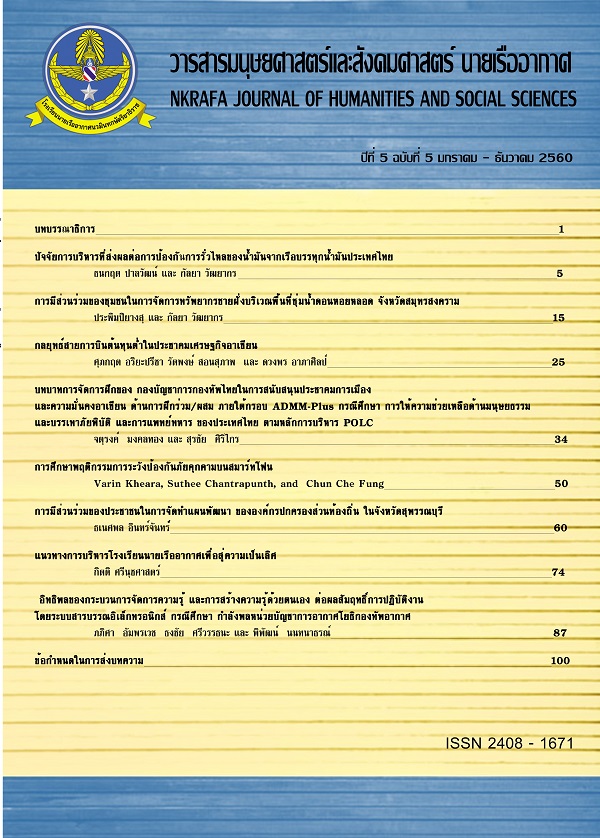Protection Motivation Theory Model for Smartphone User
Main Article Content
Abstract
Smartphones are becoming a necessity that facilitates our daily life, allowing us to connect with the outside world via the internet, and empowering work and entertainment. It is considered as an essential part of our daily lives like that never happens before. However, the more growing up using internet, the more development of cyber attacks. The attacks are not only attack on the computer system, but they are more likely to attack on smartphones as well. These attacks can be malware, identity theft, ransom, or etc. which can create various damages to the owners. The researcher used Roger R.W. (1983)’s Protection Motivation Theory (PMT),[1] originally created for studying fear appeals of patients that affected their behaviours in protecting themselves from health threats, as the base theory for studying protection behaviours of smartphone users. Objective of this study is to find factors for creating a protection behaviour model and instrument for gathering data. Results of this study are useful for studying the causal relationships among factors in the proposed model with the technique called Structural Equation Model (SEM) analysis.
Article Details
บทความที่ได้รับการตีพิมพ์เป็นลิขสิทธิ์ของวารสารมนุษยศาสตร์และสังคมศาสตร์ นายเรืออากาศ
ข้อความที่ปรากฎในบทความแต่ละเรื่องในวารสารวิชาการเล่มนี้ เป็นความคิดเห็นส่วนตัวของผู้เขียนแต่ละท่าน ไม่เกี่ยวข้องกับโรงเรียนนายเรืออากาศฯ และคณาจารย์ท่านอื่น ๆในโรงเรียนนายเรืออากาศฯ แต่อย่างใด ความรับผิดชอบขององค์ประกอบทั้งหมดของบทความแต่ละเรื่องเป็นของผู้เขียนแต่ละท่าน หากมีความผิดพลาดใด ๆ ผู้เขียนแต่ละท่านจะรับผิดชอบบทความของตนเองแต่เพียงผู้เดียว
References
[2] Rogers, R.W. A Protection Motivation Theory of Fear Appeals and Attitude Change. Journal of Psychology, 1975, 91, pp. 93-114.
[3] Rippetoe, P. and Rogers, R. W. (1987) Effects of components of protection motivation theory on adaptive and maladaptive coping with a health threat. Journal of Personality and Social Psychology, 52, 596–604.
[4] Anderson, C. L., and Agarwal, R. (2010). Practicing safe computing: a multi-method empirical examination of home computer user security behavioral intentions. MIS Quarterly, 34.
[5] Humaidi, N., and Balakrishnan, V. (2012). The Influence of Security Awareness and Security Technology on Users’ Behavior towards the Implementation of Health Information System:A Conceptual Framework. 2nd International Conference on Management and Artificial Intelligence, 35.
[6] Srisawang, Sirirat; Thongmak, Mathupayas; and Ngarmyarn, Atcharawan.(2015). Factors Affecting Computer Crime Protection Behavior. PACIS 2015, pp. 3.
[7] Maddux, J. E.; Rogers, R. W. (1983). Protection motivation and self-efficacy: A revised theory of fear appeals and attitude change. Journal of Experimental Social Psychology. 19 (5): 469–479.
[8] Woon, I., Tan, G.-W., and Low, R. (2005). A Protection Motivation Theory Approach to Home Wireless Security. ICIS 2005 Proceedings, 31.
[9] Boer, Henk and Seydel, Erwin R. (1996) Protection Motivation Theory. In: Predicting Health Behaviour: Research and Practice with Social Cognition Models. Open University Press, Buckingham, pp. 95-120.
[10] Liang, H. and Xue, Y. (2009). Avoidane of Information Technology Threats: A Theoretical Perspective. MIS Quarterly, 2009, 33(1), pp. 71 - 90.
[11] Janz, N. K., and Becker, M. H. 1984. The Health Belief Model: A Decade Later, Health Education Quarterly (11:1), pp. 1-45.
[12] Rosenstock, I. M. 1974. The Health Belief Model and Preventive Health Behavior, Health education Monographs (2), pp. 354-386.
[13] Baskerville, R. 1991a. Risk Analysis: An Interpretive Feasibility Tool in Justifying Information Systems Security, European Journal of Information Systems (1:2), pp. 121-130.
[14] Baskerville, R. 1991b. Risk Analysis as a Source of Professional Knowledge, Computer & Security (10:8), pp. 749-764.
[15] Tu, Z.L. and Yuan, Y.F. (2012). Understanding User Behavior in Coping with Security Threats of Mobile Device Loss and Theft. 45th Hawaii International Conference on System Sciences 978-0-7695-4525-7/12.


